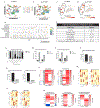Inflammatory, Functional, and Compositional Changes of the Uterine Immune Microenvironment in a Lymphangioleiomyomatosis Mouse Model
- PMID: 40893807
- PMCID: PMC12392152
- DOI: 10.33696/immunology.7.227
Inflammatory, Functional, and Compositional Changes of the Uterine Immune Microenvironment in a Lymphangioleiomyomatosis Mouse Model
Abstract
Lymphangioleiomyomatosis (LAM) is a rare, female-dominated pulmonary cystic disease. Cysts that develop in LAM are characterized by the presence of smooth muscle-like (LAMCore) cells in the periphery. These cells harbor mutations in Tuberous Sclerosis Complex 1 or 2 (TSC1/2), driving uncontrolled proliferation through the mTORC1 pathway. LAMCore cells originate from an extrapulmonary source. Published data supports the uterine origin of LAMCore cells that metastasize from the uterus to precipitate pulmonary function destruction. Immune evasion is hypothesized to occur to allow seeding of the lungs from the uterus. This evasion specifically involves dysfunctional NK cells to allow aberrant proliferation and migration from the tissue. Single-cell RNA sequencing revealed changes in chemokine and cytokine protein and receptor expression in uterine NK (uNK) and other immune cell populations in a uterine-specific Tsc2-knockout mouse model of LAM. ELISA data revealed increased concentrations of multiple pro-inflammatory cytokines in the sera of aged Tsc2-knockout mice. Flow cytometry, IHC, and functional assays identified compositional and functional insufficiencies of the uNK cells in Tsc2-knockout mice. Furthermore, depletion of NK cells led to the increased development of pulmonary metastases. These data suggest an inflammatory feedback loop affecting multiple cell types including uNK cells, macrophages, and neutrophils. This leads to alterations in immune cell function and composition which allow for LAMCore cell metastasis from the uterine tissue, which may provide a novel mechanism for LAM development.
Keywords: Inflammation; Lymphangioleiomyomatosis; NK Cells; Single-cell RNA sequencing; Uterus.
Conflict of interest statement
Conflicts of Interest The authors report no conflicts of interest.
Figures









Similar articles
-
Autocrine Transforming Growth Factor-β Signaling Promotes Cell Motility and Chemokine Secretion in an Angiomyolipoma-Derived Cell Model of Lymphangioleiomyomatosis.Am J Pathol. 2025 Aug;195(8):1394-1410. doi: 10.1016/j.ajpath.2025.04.019. Epub 2025 May 30. Am J Pathol. 2025. PMID: 40451319
-
Prescription of Controlled Substances: Benefits and Risks.2025 Jul 6. In: StatPearls [Internet]. Treasure Island (FL): StatPearls Publishing; 2025 Jan–. 2025 Jul 6. In: StatPearls [Internet]. Treasure Island (FL): StatPearls Publishing; 2025 Jan–. PMID: 30726003 Free Books & Documents.
-
Modulation of infiltrating CD206-positive macrophages restricts progression of pulmonary lymphangioleiomyomatosis (LAM).Eur Respir J. 2025 Jul 10:2500084. doi: 10.1183/13993003.00084-2025. Online ahead of print. Eur Respir J. 2025. PMID: 40639874
-
Tuberous Sclerosis Complex.1999 Jul 13 [updated 2024 Aug 1]. In: Adam MP, Feldman J, Mirzaa GM, Pagon RA, Wallace SE, Amemiya A, editors. GeneReviews® [Internet]. Seattle (WA): University of Washington, Seattle; 1993–2025. 1999 Jul 13 [updated 2024 Aug 1]. In: Adam MP, Feldman J, Mirzaa GM, Pagon RA, Wallace SE, Amemiya A, editors. GeneReviews® [Internet]. Seattle (WA): University of Washington, Seattle; 1993–2025. PMID: 20301399 Free Books & Documents. Review.
-
Current concepts in the pathogenesis and clinical management of lymphangioleiomyomatosis.Curr Opin Pulm Med. 2025 Sep 1;31(5):494-503. doi: 10.1097/MCP.0000000000001185. Epub 2025 Jun 12. Curr Opin Pulm Med. 2025. PMID: 40501369 Review.
References
-
- McCarthy C, Gupta N, Johnson SR, Yu JJ, McCormack FX. Lymphangioleiomyomatosis: pathogenesis, clinical features, diagnosis, and management. Lancet Respir Med. 2021;9(11):1313–27. - PubMed
Grants and funding
LinkOut - more resources
Full Text Sources
